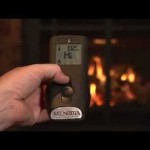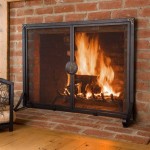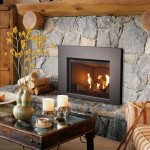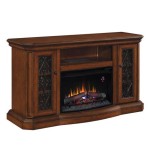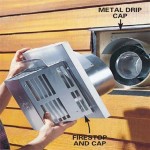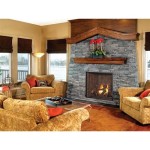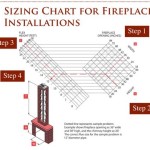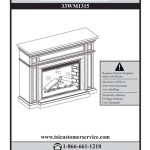Safe To Put TV Above Gas Fireplace: Considerations and Precautions
The placement of a television above a gas fireplace is a common interior design consideration, driven by a desire for space efficiency and aesthetic appeal. However, this arrangement presents potential risks related to heat exposure and structural integrity. Careful planning and execution are crucial to ensure both the longevity of the television and the safety of the occupants.
The primary concern stems from the heat generated by the fireplace. Electronic components, including those found in televisions, are susceptible to damage when exposed to excessive heat. Elevated temperatures can lead to a shortened lifespan, performance degradation, and even complete failure of the television. Therefore, assessing the potential heat output of the fireplace and implementing mitigation strategies is paramount.
Beyond heat, structural considerations play a significant role. The wall above the fireplace must be capable of supporting the weight of the television, and the mounting hardware must be appropriately selected and installed. Furthermore, the presence of a chimney or flue within the wall can influence the placement and mounting options. Ignoring these structural factors can result in the television falling, causing damage to property and posing a safety hazard.
Understanding Heat Output and Mitigation
The amount of heat produced by a gas fireplace varies significantly depending on several factors, including the size of the fireplace, the type of gas used (natural gas or propane), the efficiency of the fireplace, and the duration of operation. A high-output fireplace, particularly one used frequently or for extended periods, poses a greater risk to a television mounted above it.
Several methods can be employed to mitigate the effects of heat on the television. One common approach involves installing a mantel or shelf above the fireplace. This acts as a heat shield, deflecting rising heat away from the television. The effectiveness of the mantel depends on its size, material, and placement. A wider and deeper mantel provides greater protection.
Another strategy is to increase the distance between the fireplace and the television. A greater vertical distance provides more opportunity for the heat to dissipate before reaching the television. This may require raising the television higher on the wall, which can impact viewing angles and aesthetics. Careful consideration must be given to ensure comfortable viewing from the typical seating position.
Ventilation also plays a crucial role in managing heat. Ensuring adequate airflow around the television helps to prevent heat from building up. This can be achieved by avoiding enclosed spaces behind the television and by strategically placing ventilation openings to promote air circulation. Some specialized TV mounts incorporate built-in ventilation systems to further enhance cooling.
Regular monitoring of the temperature above the fireplace is recommended, especially during the initial period after installation. A simple thermometer placed near the television can provide valuable data on the actual temperature levels. If the temperature consistently exceeds the manufacturer's recommended operating range for the television (typically found in the owner's manual), further mitigation measures are necessary.
Assessing Structural Integrity and Mounting Options
Before mounting a television above a gas fireplace, a thorough assessment of the wall's structural integrity is essential. The wall must be capable of supporting the combined weight of the television and the mounting hardware. This assessment should consider the type of wall construction (e.g., drywall, plaster, brick, concrete), the presence of studs or other framing elements, and the weight-bearing capacity of these elements.
Drywall alone is generally insufficient to support the weight of a television, particularly larger models. It is crucial to anchor the mounting hardware to wall studs or other structural members. Stud finders can be used to locate studs behind the drywall. If studs are not located in the ideal position for mounting, alternative solutions such as specialized drywall anchors or mounting plates that distribute the weight over a wider area may be necessary. However, these alternatives should be used with caution and only when recommended by the mounting hardware manufacturer.
For brick or concrete walls, specialized anchors designed for masonry are required. These anchors must be appropriately sized and installed according to the manufacturer's instructions. Drilling into brick or concrete requires specialized tools and techniques to avoid damaging the wall. If uncertain, consulting a professional installer is advisable.
The choice of mounting hardware is also critical. The mount should be specifically designed for the size and weight of the television. Different types of mounts are available, including fixed mounts, tilting mounts, and full-motion mounts. Fixed mounts provide the most stable and secure option, while tilting and full-motion mounts offer greater flexibility in viewing angles but may be less stable and require more robust wall support.
Proper cable management is another important consideration. Cables should be routed neatly and securely to prevent them from dangling or being exposed to heat. Cable management channels or sleeves can be used to conceal and protect the cables. It is also advisable to use high-quality cables that are rated for high-temperature environments.
Considering Alternatives and Professional Consultation
If concerns about heat or structural integrity persist, alternative placement options for the television should be explored. Placing the television on a separate wall, or in a different part of the room, can eliminate the risks associated with mounting it above the fireplace. This may require rearranging the furniture or reconfiguring the room layout, but it can ultimately provide a safer and more suitable viewing experience.
Another alternative is to use a fireplace mantel mount. These mounts are designed to lower the television to a comfortable viewing height when in use and raise it up and away from the heat when the fireplace is on. This type of mount offers a flexible solution for those who want to enjoy both the fireplace and the television in the same space.
Before proceeding with any installation, consulting with a qualified professional is highly recommended. A professional installer can assess the specific conditions of the room, evaluate the heat output of the fireplace, determine the structural integrity of the wall, and recommend the most appropriate mounting solution. They can also ensure that the installation is performed safely and correctly, minimizing the risk of damage to the television or the surrounding structure.
In addition to a professional installer, consulting with an electrician may be necessary, especially if electrical outlets need to be relocated or additional wiring is required. An electrician can ensure that the electrical work is performed safely and in compliance with local codes. Similarly, consulting with a fireplace specialist can provide valuable insights into the heat output characteristics of the fireplace and recommend strategies for mitigating heat exposure.
Ultimately, the decision of whether or not to mount a television above a gas fireplace is a personal one that should be based on a careful assessment of the potential risks and benefits. By understanding the factors involved and taking appropriate precautions, it is possible to create a safe and aesthetically pleasing entertainment setup. However, prioritizing safety and consulting with professionals is crucial to minimizing the risk of damage and ensuring a positive outcome.

Ortal S Innovative Technology Makes It Safe To Mount A Tv Above Your Fireplace

Can You Put A Tv Above Fireplace

ᑕ❶ᑐ What To Consider Before Mounting A Tv Above Fireplace

Mounting Your Tv Above Fireplace

ᑕ❶ᑐ What To Consider Before Mounting A Tv Above Fireplace

How To Safely Mount Your Tv Above The Fireplace

Gazco Studio 3 Gas Fire Rigbys

Can You Put A Tv Above Fireplace

Tv Above Gas Fire Houzz

Pros And Cons Of Mounting Your Tv Over Fireplace Vancouver Gas Fireplaces
Related Posts

